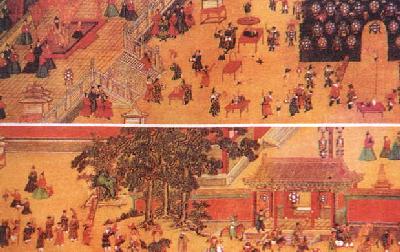In ancient Chinese arts and crafts, we can often see vivid images of acrobatics and painters also like to draw pictures about acrobatic performances. Some valuable works of art handed down faithfully depicts acrobatic development at that time and also shows the important position of the art of acrobatics in people's life.
 |
| The mural An Outing by the Lady of Song, found in Dunhuang Mogao Grottos |
The mural
An Outing by the Lady of Songof the Tang Dynasty (618-907) depicts the grand scene of a peeress's outing. Walking in front of the large procession is an acrobat doing pole balancing with four young boy doing stunts. These figures are vivid, lively and vigorous. This piece of work is the most complete acrobatic mural.
Qishi Dangong(Lacquered Slingshot) of the Tang Dynasty depicts a splendid scene of an acrobatic performance. The work has seven sections, including singing and dancing performance, pole balancing, people pyramid and pole balancing with three people scrambling and one girl in a plate on top of the pole and so on.
The Hoop-Handle Silver Pot of the Tang Dynasty, unearthed in the southern suburb of Xi'an in Shaanxi Province in 1997, is a pot that imitates the appearance of a leather bag. This pot has a decorative design of a horse on both sides of the pot body with a ribbon around its neck and its tail flowing in the air. The horse holds a drinking cup in its mouth -- an allusion to poetry from the period describing the "dancing horses".
Bianqiao Huimeng Tu(Alignment at Temporary Bridge) drawn by Chen Sheli of the Liao Dynasty (916-1125) is a large-scale picture scroll depicting the alignment between Tang Emperor Li Shimin and Khan Jieli of the Turks nationality in 626 at a temporary bridge over Weishui River. At the very beginning of the picture is splendid horsemanship performance. The picture scroll not only vividly depicts the excellent horsemanship of the Tang Dynasty but also records the importance of horsemanship in this political event.
Horsemanship Color-Blazed Ceramic Pillowof the Song Dynasty (960-1279), kept in the Palace Museum in Beijing, vividly depicts the performance of horsemanship, which reflects the horsemanship level and people's love for horsemanship in the Song Dynasty.
 |
| Ming Emperor Xianzong Makes Merry |
Ming Emperor Xianzong Makes Merry, a picture roll painted in 1485 in the Ming Dynasty (1368-1644), specially describes the acrobatic performances in the imperial court of that time. The work is divided into three parts, with each part focusing on one theme.
Many drawings about folk customs took acrobatics as their subject matters, such asBaxian at Yuyuan Garden, and Dancing Lions, etc., painted by Wu Youru at the end of the Qing Dynasty (1644-1911), paintings about acrobatics in the Qing Dynasty collected by Mr. Cheng Yanqiu during his lifetime, and so on.
